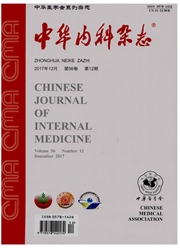

 中文摘要:
中文摘要:
目的探讨血清甲状腺刺激性抗体(TSAb)、甲状腺刺激阻断性抗体(TSBAb)等甲状腺自身抗体、碘摄入量与Graves病(GD)甲状腺功能亢进症(甲亢)发病和转归的关系。方法测定3个不同碘摄入量地区63例临床甲亢患者的血清TSAb、TSBAb、促甲状腺激素结合抑制免疫球蛋白(TBⅡ)、甲状腺过氧化物酶抗体(TPOAb)和甲状腺球蛋白抗体(TGAb),2年后随访。TSAb和TSBAb采用转染了重组人促甲状腺素受体的中国仓鼠卵巢细胞(rhTSHR—CHO细胞)生物法测定。结果初访GD甲亢患者TSAb、TBⅡ和TSBAb的阳性率分别为80.9%、61.7%和6.4%,TSAb和TBⅡ任-抗体阳性率为91.5%,显著高于对照组。TSAb和TBⅡ的一致率为59.6%。GD甲亢患者TSAb与TBⅡ(r=0.407)、甲状腺球蛋白(r=0、301)、甲状腺体积(r=0.317)正相关。初访碘过量地区GD甲亢患者TSAb阳性率(91.7%)显著高于轻度碘缺乏地区(66.7%),3个地区GD患者TBⅡ、TPOAb、TGAb阳性率、活性和甲状腺体积无统计学差异。随访时患者分为甲状腺功能恢复组(G1)和未恢复组(G2)。G1组TSAb活性和甲状腺体积显著下降。当TPOAb滴度显著增高,且随访时继续保持高滴度时,甲状腺功能不易恢复。此时TSAb对甲状腺功能的影响降为次要因素。结论TSAb对GD甲亢的诊断和判断临床转归的意义大于TBⅡ,联合应用二者能提高GD甲亢患者促甲状腺激素受体抗体的检出率;GD甲亢的转归与TSAb、TPOAb浓度和甲状腺体积有关。
 英文摘要:
英文摘要:
Objective To investigate the relationship of thyroid autoantibodies including serum thyroid stimulating antibody (TSAb), thyroid stimulation blocking antibody(TSBAb) and iodine intake with the development and prognosis of Graves' hyperthyroidism. Methods A total of 63 subjects with overt hyperthyroidism were screened out from 3 Chinese rural communities with different iodine intakes at first survey. Serum TSAb, TSBAb, thyrotropin binding inhibitory immunoglobulin (TB Ⅱ), thyroid peroxidase antibody (TPOAb) and thyroglobulin antibody (TGAb) were detected. The patients were followed up 2 years later. TSAb and TSBAb were measured with recombinant human thyrotropin receptor (rhTSHR)-Chinese hamster ovary cell(rhTSHR-CHO cell) bioassay. Results At the first survey, the prevalences of positive TSAb, TB Ⅱ and TSBAb were found in 80. 9%, 61.7% and 6. 4% of the patients with Graves' disease respectively. TSAb and/or TB Ⅱ were positive in 91.5% of the patients. The consistent rate of TSAb and TB Ⅱwas 59. 6% in the cases. All indexes mentioned above were higher in the patients than in healthy controls. Positive correlations were found between TSAb and TB Ⅱ( r = 0. 407 ), TSAb and thyroglobulin (r =0. 301 ), TSAb and thyroid volume ( r = 0. 317 ) respectively. The prevalence of positive TSAb (91.7%) in Graves' patients in iodine excessive area are significantly higher than those in iodine mildly deficient area(66. 7% ). The positive rates and the titers of TB Ⅱ , TPOAb and TGAb were not different statistically among the patients in the three communities. At follow-up, the patients with Graves' hyperthyroidism were classified into euthyroid group ( G1 ) and hyperthyroid group (G2) according to their outcomes of the disease. The TSAb titers and the thyroid volume in the cases of G1 decreased significantly, whereas the patients with highly positive TPOAb titers in the first survey and the follow-up were hard to become euthyroid and TSAb may be the secon
 同期刊论文项目
同期刊论文项目
 同项目期刊论文
同项目期刊论文
 期刊信息
期刊信息
